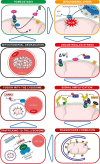Parkinson's disease and mitophagy: an emerging role for LRRK2
- PMID: 33769432
- PMCID: PMC8106497
- DOI: 10.1042/BST20190236
Parkinson's disease and mitophagy: an emerging role for LRRK2
Abstract
Parkinson's disease (PD) is a progressive neurodegenerative disorder that affects around 2% of individuals over 60 years old. It is characterised by the loss of dopaminergic neurons in the substantia nigra pars compacta of the midbrain, which is thought to account for the major clinical symptoms such as tremor, slowness of movement and muscle stiffness. Its aetiology is poorly understood as the physiological and molecular mechanisms leading to this neuronal loss are currently unclear. However, mitochondrial and lysosomal dysfunction seem to play a central role in this disease. In recent years, defective mitochondrial elimination through autophagy, termed mitophagy, has emerged as a potential contributing factor to disease pathology. PINK1 and Parkin, two proteins mutated in familial PD, were found to eliminate mitochondria under distinct mitochondrial depolarisation-induced stress. However, PINK1 and Parkin are not essential for all types of mitophagy and such pathways occur in most cell types and tissues in vivo, even in the absence of overt mitochondrial stress - so-called basal mitophagy. The most common mutation in PD, that of glycine at position 2019 to serine in the protein kinase LRRK2, results in increased activity and this was recently shown to disrupt basal mitophagy in vivo. Thus, different modalities of mitophagy are affected by distinct proteins implicated in PD, suggesting impaired mitophagy may be a common denominator for the disease. In this short review, we discuss the current knowledge about the link between PD pathogenic mutations and mitophagy, with a particular focus on LRRK2.
Keywords: Parkinsons disease; autophagy; leucine-rich repeat kinase; mitophagy.
© 2021 The Author(s).
Conflict of interest statement
The authors declare that there are no competing interests associated with the manuscript.
Figures


References
-
- United Nations - Department of Economic and Social Affairs. World Population Ageing 2019 [Internet]. 2019 [cited 2020 Nov 9]. Available from: https://www.un.org/development/desa/pd/sites/www.un.org.development.desa...
Publication types
MeSH terms
Substances
Grants and funding
LinkOut - more resources
Full Text Sources
Other Literature Sources
Medical
Miscellaneous

